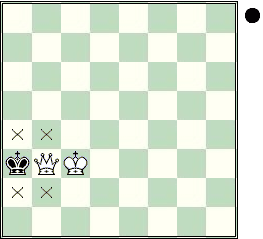 | The Queen is a very powerful piece, but even this powerful white piece is not able to checkmate the black king by itself. The white king is needed to support the queen. This kind of endgame is very common when a player has managed to promote a pawn. Attention has to be paid to avoid a stalemate and the mate must be reached within 50 moves as it is a draw if 50 consecutive moves occur without a capture or pawn move. | |
 | Theoretically the maximum number of moves that is needed to checkmate is 10 which corresponds to the position of the upper board on the left side. First the black king is imprisoned as shown in the second diagram by 1.Qe5 Then the king has to come to assist the queen: 1…Kd3 2.Kg7 Kc4 3.Kf6 Kd3 4.Kf5 Kc4 5.Ke4 Kb3 | |
 | And the prison is made smaller: 6.Qc5 Ka4 If Black plays 6…Kb2 the reply is 7.Kd3. A smaller prison by 7.Qb6 and again the white king has to approach: …Ka3 8.Kd3 Ka2 9.Kc3 Ka3 | |
 | After 9…Ka1 white mates with 10.Qb2#
but now it is: 10.Qb3# It is a good exercise trying to visualize all the checkmating patterns with the queen and king. |
Are you already able to checkmate with the rook?





